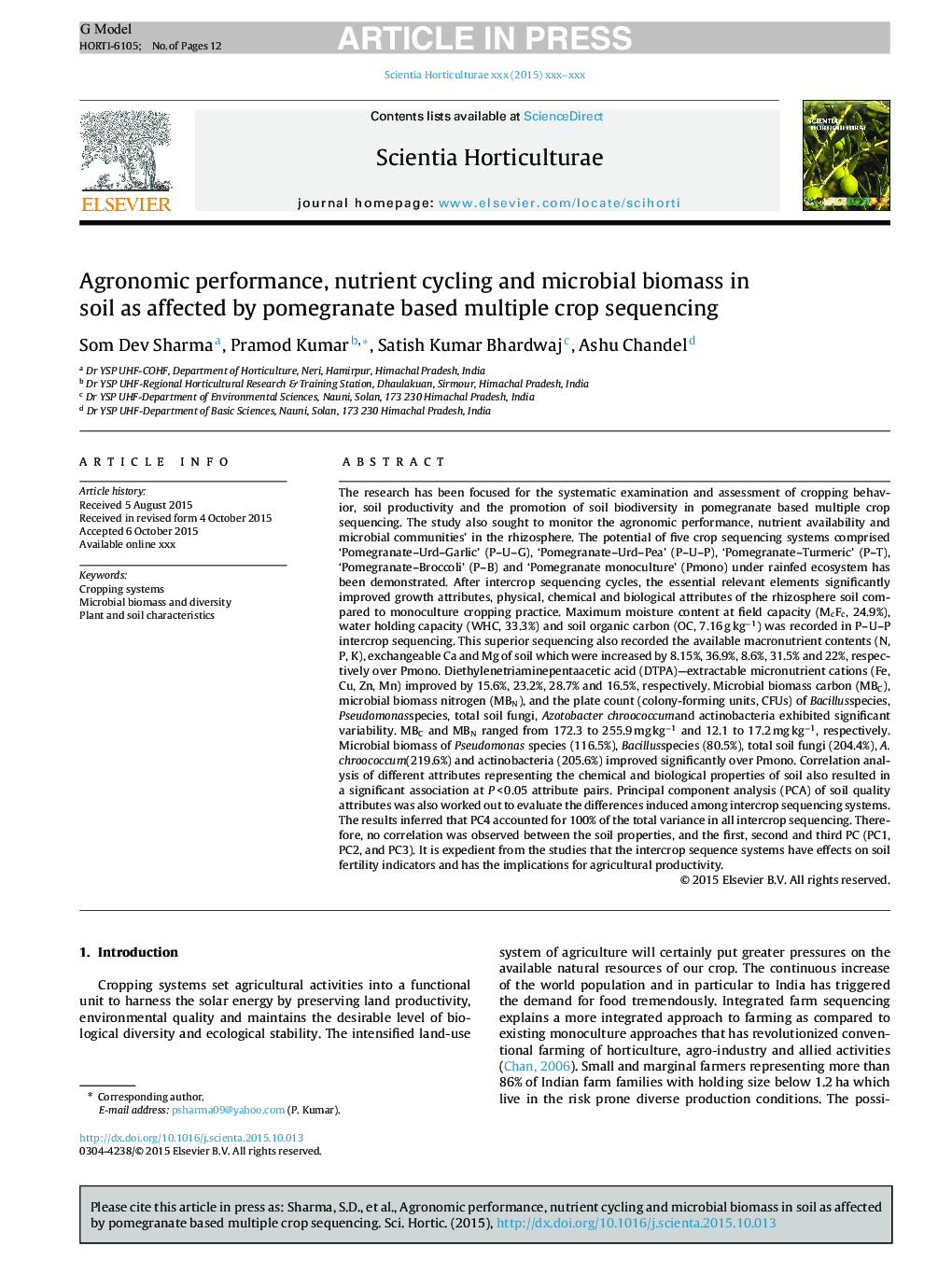| کد مقاله | کد نشریه | سال انتشار | مقاله انگلیسی | نسخه تمام متن |
|---|---|---|---|---|
| 6406853 | 1628801 | 2015 | 12 صفحه PDF | دانلود رایگان |
عنوان انگلیسی مقاله ISI
Agronomic performance, nutrient cycling and microbial biomass in soil as affected by pomegranate based multiple crop sequencing
ترجمه فارسی عنوان
عملکرد زراعی، دوچرخه سواری مواد مغذی و بیوماس میکروبی در خاک تحت تأثیر انقراض چندگانه بر پایه ی انار
دانلود مقاله + سفارش ترجمه
دانلود مقاله ISI انگلیسی
رایگان برای ایرانیان
کلمات کلیدی
سیستم های برداشت زیست توده و تنوع میکروبی، ویژگی های گیاه و خاک،
موضوعات مرتبط
علوم زیستی و بیوفناوری
علوم کشاورزی و بیولوژیک
دانش باغداری
چکیده انگلیسی
The research has been focused for the systematic examination and assessment of cropping behavior, soil productivity and the promotion of soil biodiversity in pomegranate based multiple crop sequencing. The study also sought to monitor the agronomic performance, nutrient availability and microbial communities' in the rhizosphere. The potential of five crop sequencing systems comprised 'Pomegranate-Urd-Garlic' (P-U-G), 'Pomegranate-Urd-Pea' (P-U-P), 'Pomegranate-Turmeric' (P-T), 'Pomegranate-Broccoli' (P-B) and 'Pomegranate monoculture' (Pmono) under rainfed ecosystem has been demonstrated. After intercrop sequencing cycles, the essential relevant elements significantly improved growth attributes, physical, chemical and biological attributes of the rhizosphere soil compared to monoculture cropping practice. Maximum moisture content at field capacity (McFc, 24.9%), water holding capacity (WHC, 33.3%) and soil organic carbon (OC, 7.16 g kgâ1) was recorded in P-U-P intercrop sequencing. This superior sequencing also recorded the available macronutrient contents (N, P, K), exchangeable Ca and Mg of soil which were increased by 8.15%, 36.9%, 8.6%, 31.5% and 22%, respectively over Pmono. Diethylenetriaminepentaacetic acid (DTPA)-extractable micronutrient cations (Fe, Cu, Zn, Mn) improved by 15.6%, 23.2%, 28.7% and 16.5%, respectively. Microbial biomass carbon (MBC), microbial biomass nitrogen (MBN), and the plate count (colony-forming units, CFUs) of Bacillusspecies, Pseudomonasspecies, total soil fungi, Azotobacter chroococcumand actinobacteria exhibited significant variability. MBC and MBN ranged from 172.3 to 255.9 mg kgâ1 and 12.1 to 17.2 mg kgâ1, respectively. Microbial biomass of Pseudomonas species (116.5%), Bacillusspecies (80.5%), total soil fungi (204.4%), A. chroococcum(219.6%) and actinobacteria (205.6%) improved significantly over Pmono. Correlation analysis of different attributes representing the chemical and biological properties of soil also resulted in a significant association at P < 0.05 attribute pairs. Principal component analysis (PCA) of soil quality attributes was also worked out to evaluate the differences induced among intercrop sequencing systems. The results inferred that PC4 accounted for 100% of the total variance in all intercrop sequencing. Therefore, no correlation was observed between the soil properties, and the first, second and third PC (PC1, PC2, and PC3). It is expedient from the studies that the intercrop sequence systems have effects on soil fertility indicators and has the implications for agricultural productivity.
ناشر
Database: Elsevier - ScienceDirect (ساینس دایرکت)
Journal: Scientia Horticulturae - Volume 197, 14 December 2015, Pages 504-515
Journal: Scientia Horticulturae - Volume 197, 14 December 2015, Pages 504-515
نویسندگان
Som Dev Sharma, Pramod Kumar, Satish Kumar Bhardwaj, Ashu Chandel,
